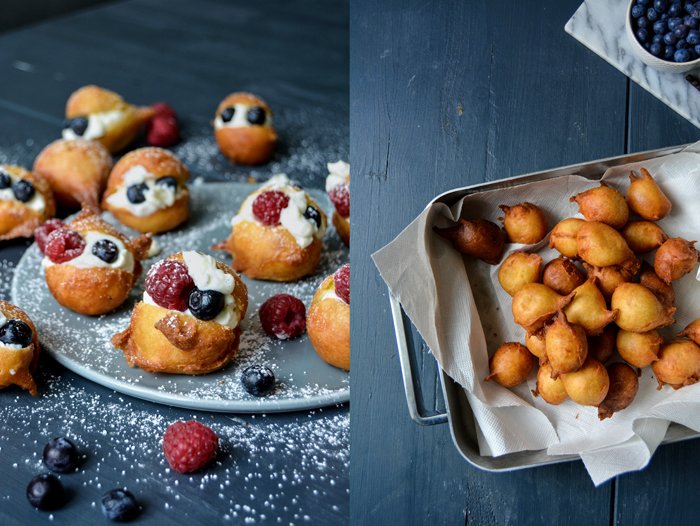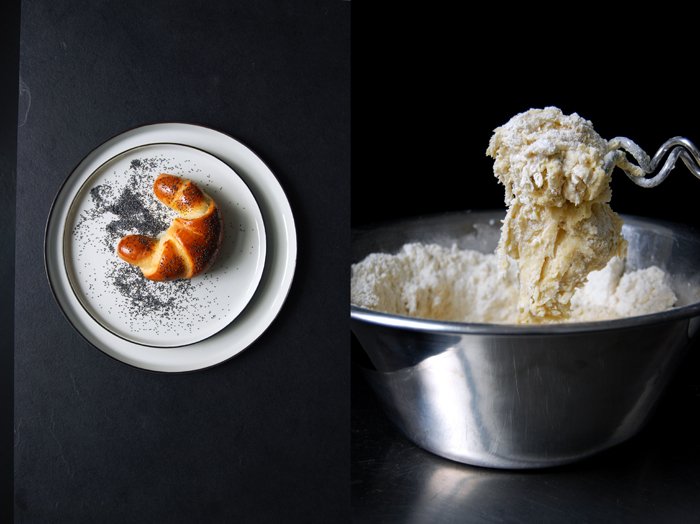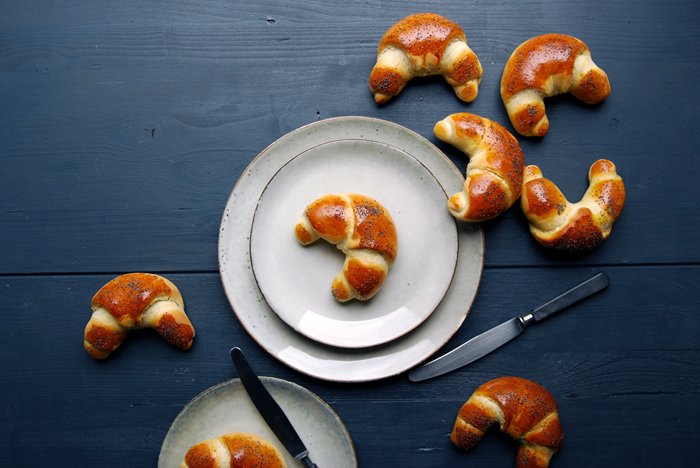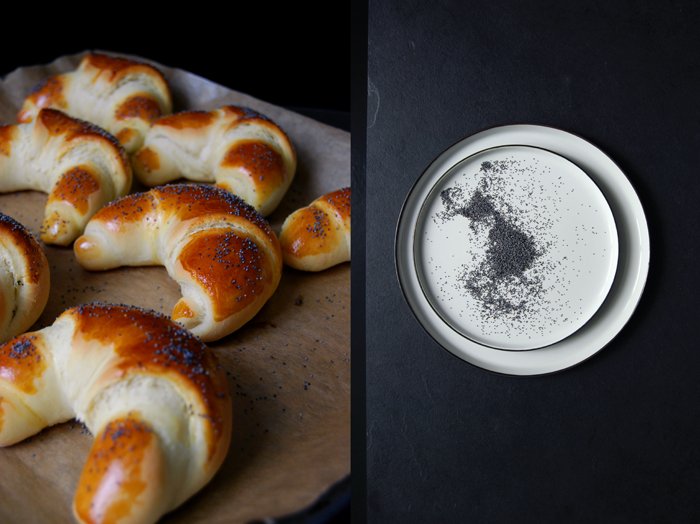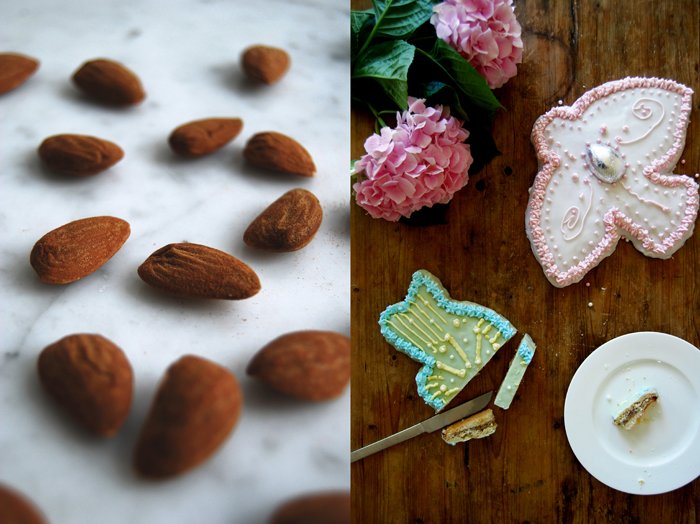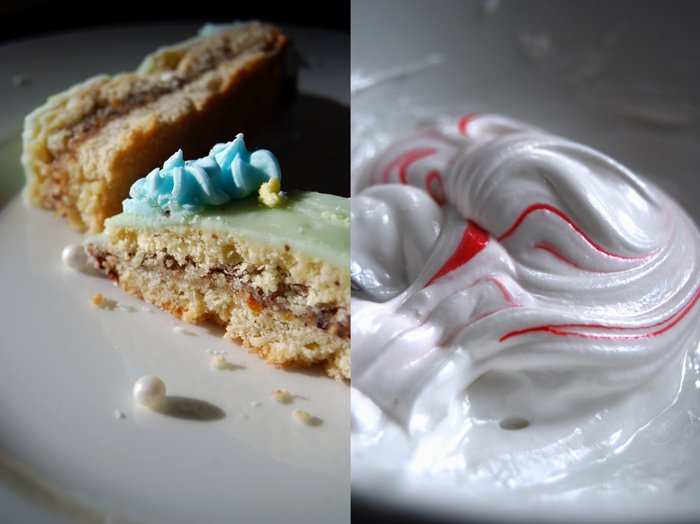Maltese Zeppoli - Fried Cream Puffs with Vanilla Ricotta and Fresh Berries
My Maltese family has been telling me about zeppoli - or zeppole in Italian - for many, many years. Countless stories about these puffy, tiny balls of choux pastry, fried to golden perfection, and filled with ricotta, fed my curiosity and made my mouth water. In Malta, the little sweets, also known as sfineġ, are traditionally made on the 19th March to celebrate the feast of St. Joseph. The filling is rich, refined with chocolate and candied peel and fruit, and topped with chopped hazelnuts. In other parts of the Mediterranean, like southern Italy, Sicily, and Sardinia, you can also find them plain, rolled in sugar, dipped in melted chocolate, or topped with vanilla custard. There wasn't the slightest doubt which version I'd go for.
The problem is, when you have an idea of a classic dish without actually ever having tried it, it becomes a dish of its own. In my mind, I always imagined the little puff balls filled with pretty berries. I couldn't really see the chopped chocolate bits but lots of vanilla freshly scraped out of its pod, sweet orange juice, and fragrant Maltese honey stirred into the creamy ricotta. I have an excuse, I've never been to the Maltese archipelago on St. Joseph's special day, so I have never tried a single original zeppoli. Therefore, I just used my imagination and my critical Maltese man, and gave this project a go in my kitchen. I'm not the biggest fan of deep-frying - and some zeppoli recipes even allow you to bake the pastry in the oven - but I didn't want to move away from its origin too much. I made 26 of the crisp balls and to my surprise, they all turned out well, apart from the usual 2 to 3 first trials to find the right temperature setting. It should be relatively low, on medium, so that the inside can cook long enough without burning on the outside - golden and crisp should be the goal. The filling was delicious, fine and aromatic, and a couple raspberries and blueberries on top made it summery fresh. I was more than pleased with the result, and so was my Maltese man, the last zeppoli 'disappeared' after dinner.
There's also a savoury version of this dish, filled with anchovies, however, my imagination fails to give me an idea of how this would taste. I guess I have to go to Malta for this culinary experience. If you're into deep-fried sweets, you can also try my Greek Loukoumades, made with yeast dough.
Have a Happy Easter with your loved ones and enjoy lots of chocolate eggs! xx
Maltese Zeppoli - Fried Cream Puffs with Vanilla Ricotta and Berries
Makes about 26 cream puffs
For the filling
fresh ricotta 250g / 9 ounces
flowery honey, such as orange blossom, 1 tablespoon
freshly squeezed orange juice 1 tablespoon
vanilla pod, scraped, 1/2raspberries, 1 small handful (about 100g / 3 1/2 ounces)
blueberries, 1 small handful (about 100g / 3 1/2 ounces)
For the choux pastry
sunflower oil, about 1 1/2l / 6 cups, to fry the pastry
unsalted butter 120g / 1/2 cup
granulated sugar 50g / 4 tablespoons
fine sea salt 1/8 teaspoon
water 120ml / 1/2 cup
plain flour, sieved, 130g / 1 cup
organic eggs 3
For the topping
icing sugar
For the ricotta filling, in a medium bowl, whisk the ricotta, honey, orange juice, and vanilla seeds until creamy. Season with honey and vanilla to taste. Keep the ricotta in the fridge until you fill the choux pastry.
In a large, heavy pot, heat the sunflower oil on medium-high heat. Line a large baking dish with kitchen paper.
For the pastry, in a large pot, bring the butter, sugar, salt, and water to the boil. Turn the heat down to low, stir in the flour vigorously with a wooden spoon, and mix until smooth and the dough comes away from the side of the pan. Transfer the dough to a bowl and let it cool for about 10 minutes. Beat the eggs in with a spoon, 1 at a time, only mix in the next one when the one before is well combined.
When the oil is hot - dip in the bottom end of a wooden spoon, little bubbles, should form around it - scoop out 1 heaping teaspoon of the dough and carefully scrape it with a second teaspoon into the hot oil. Start with 2 balls of dough to adjust the temperature, you might have to turn the heat down to medium or a little bit lower. The pastry has to cook for 4-6 minutes for the inside to be cooked through. The outside should be golden and not dark brown. If they become dark after 2-3 minutes, turn the heat down. Transfer the cooked zeppoli to the lined baking dish and continue frying the remaining dough. Let them cool completely.
Using a sharp knife, cut a wide slit in the top part of each zeppoli and fill with a spoonful of the vanilla ricotta. Top with 2-3 berries, sprinkle with icing sugar, and serve. Once the zeppoli are filled, they should be enjoyed within the next hour as the ricotta soaks the pastry.
Crescent Milk Rolls with Poppy Seeds for Easter Breakfast
One of my earliest Easter memories is searching for Easter eggs with my sister in the garden of the house we had just moved into. There was no fence around the lawn, the green grass sprinkled with red tulips opened up to a dense forest, my childhood playground. We were young and so excited, the kind of overwhelming excitement we tend to neglect as we get older. On that sunny April day many years ago, we forgot about everything around us as we found our Easter presents hidden behind a group of old oak trees: 80's roller skates in flashing red and white, it was better than Christmas!
I still love these special feasts, not for the presents but for these pure moments of bliss, when we take a break from our normal routine, slow down the pace and relax a little, or reflect on the memories filling our book of life. To me, memories are as precious as the moment itself and I wouldn't have started a food blog if they weren't inseparably connected with dishes, meals and recipes, at least most of the time. Easter Sunday is perfect for a long breakfast, preferably outside in the sunshine, which, unfortunately, isn't really an option in Berlin at the moment. We're still in the hands of snow, hail and rain! But snuggled into a blanket at our cosy wooden table feels just as nice, especially if there are crescent milk rolls, Milchhörnchen in German, involved. I love these yeast rolls warm, fresh out of the oven, when the soft inside smells almost buttery-sweet. The thin crust is sprinkled with crunchy poppy seeds which adds a slightly nutty nuance, to me they are best with a little butter and maybe, some homemade strawberry jam, but that's not even necessary. Happy Easter!
Crescent Milk Rolls with Poppy Seeds
For 10 rolls you need
plain flour 500g / 1 pound
granulated sugar 3 tablespoons
dry yeast 1 sachet (7g / 1/4 ounce)
salt 1 teaspoon
milk, lukewarm, 220ml / 7 1/2 ounces
butter, melted, 40g / 1 1/2 ounces
organic egg 1 plus 1 egg yolk, beaten, for the glaze
poppy seeds, for the topping
In a large bowl, combine the flour, sugar, yeast and salt. Whisk the milk, melted butter and egg in another bowl, the mixture should be lukewarm. Add to the dry flour-sugar mixture and mix with the dough hooks of your mixer for a few minutes until the dough is well combined and elastic. Continue kneading with your hands for about 5 minutes until you have a soft and silky dough ball. Put the dough back into the bowl, cover with a tea towel and let it rise in the warm oven (35°C / 95°F) for 70 minutes (top/ bottom heat and not fan-assisted!).
Take the bowl out of the oven, punch the dough down and knead for another 30 seconds. Divide the dough into 10 portions (each about 80g / 3 ounces). Roll each of them to a smooth ball in your hands before you roll it out on the kitchen top with a rolling pin. Give it the shape of a 20cm / 8" long triangle, roll it up towards the tip and bend the roll into a crescent. Continue with the remaining dough and place the rolls on a baking sheet lined with parchment paper. Cover with a tea towel and let them rise in a warm place for another 20 minutes.
Set the oven to 220°C / 430°F (top-bottom heat).
Brush the top of the milk rolls with the beaten egg yolk and sprinkle with poppy seeds (you can use more than you can see in the pictures). Bake in the warm oven for about 10-12 minutes or until golden on top. They are best on the first day!
Traditional Maltese Easter Figolli
There are three cultures which have a big influence on my life, the German which I grew up with and the Maltese and the American through my boyfriend and his family. Our life is a daily mix of different traditions, habits, mentalities and languages, this is a gift to me but it also brings a lot of potential to create friction. The German and the Maltese background especially couldn't be more different. My Northern European mind, focussing on logic and order, black and white thinking, clashes sometimes (often) with the Mediterranean mentality, its relaxed trust in life, its chilled out pace, its emotional and sometimes dramatic approach to conflicts of any kind. It can be frustrating, for both sides, but it has made our lives so much richer! It's a challenge, testing out how much one is willing to accept that we are all different. I want to stay open for this experience which involves so much love from and for so many people and on top it is so much fun and entertainment and there's plenty of that! When I'm together with my Maltese family, after all theses years we're still confronted with cultural misunderstandings that bring us to tears as we have to laugh so hard. When my German seriousness clashes with Mediterranean humour, the potential for comic situations is practically never ending!
The cakes and pictures in my posts from yesterday and today couldn't reflect the two cultures and differences in a better way. Yesterday's eggnog sponge cake with whipped cream, its clean and minimal look, the concentrated focus on the pure taste of German eggnog meets today's Maltese figolla which is opulent and dramatic, lusciously and colourfully decorated. It's stuffed with various exotic flavours like orange, cinnamon and almonds. Two cultures packed in two cakes!
Figolli is the plural for figolla coming from the Latin word figura, it's a famous traditional treat eaten on Easter Sunday in Malta. To me, it's a bit like a big cookieish cake although every Maltese would disagree with that. Originally it was made in the shape of a woman, a man, a fish or a basket, ancient symbols of fertility like the chocolate egg which is always placed on top of each figolla. Without the egg (which is actually cut in half) it's not an original figolla! Times changed and more shapes became popular such as lambs, hearts, stars and a few other Easter related figures. I was given a fish and a bird by my mother in law and to be honest I was happy about her choice as the dough extends quite a bit while it's baking. I have my doubts that, if she had given me a lamb, there would have been any association left with this animal.
The decoration of a figolla is very important and involves lots of colourful sugar coating and icing. The pastry itself is made of a short crust like dough, sandwiched and filled with almond paste. There are lots of different recipes, my Maltese family gave me about six to prepare me for this experience. I was very thankful for this support but in the end I took a bit of each and added and changed after my own taste. The almond paste for example had to be exchanged with a hazelnut paste with a hint of almonds enhanced with orange zest and cinnamon. When it came to decorating the figolla I was happy to have my assisting sister in law Julia at my side to give me stylistic instructions. That's what she does when she makes figolli in Malta together with one of her aunts.
When I wrote about my rhubarb meringue tartlets last week I had mentioned that I'm not the best decorator when it comes to pastry. After we managed to put around 1kg (2 pounds) of icing sugar in both the lemony sugar glaze and in the royal icing which is made with egg whites and used for the icing decoration, we were equipped with two thick pastes and food colouring, we were ready to start! I was prepared that decorating a figolla would be very difficult, maybe stressful but I was mistaken. It was fun and I can admit that we were quite impressed with the results. I was an inexperienced German beginner after all but thanks to our North-South European cooperation we were rewarded with two beautiful and delicious figolli!
I wish you a Happy Easter!
Traditional Maltese Figolli
You need figolli cutters with a high rim.
For two big figolli (around 30cm x 20cm / 12" x 8") you need
For the dough
plain flour 400g / 14 ounces
granulated sugar 200g / 7 ounces
a pinch of salt
zest of 1 lemon
a pinch of fresh vanilla
butter 200g / 7 ounces
organic eggs 2
Combine the flour with the sugar, lemon zest, vanilla and salt. Cut the butter with a knife into the flour until there are just little pieces of butter left. Continue with your fingers and work the butter into the flour until combined (there shouldn’t be any lumps of butter left). Add the eggs and continue mixing with the hooks of your mixer until combined, the dough will be a bit sticky and soft. Form a flat ball, wrap in cling film and put in the fridge for at least 1 hour.
For the hazelnut/ almond paste
hazelnuts, ground 90g / 3 ounces
almonds, ground 60g / 2 ounces (you can also use just 150g of almonds or just hazelnuts if you prefer)
granulated sugar 100g / 3.5 ounces
ground cinnamon 1/2 teaspoon
zest of 1 orange
juice of 1/2 orange
organic egg whites 2
Combine the dry ingredients and add the orange juice. In a separate bowl, mix the egg whites until stiff, add the hazelnut-almond mixture and mix to a thick paste.
For the figolli
Set the oven to 180°C/ 355°F (fan-assisted oven) and line 2 baking sheets with parchment paper.
Divide the dough into 4 pieces, roll each one out between cling film (about 3/4 cm / 1/3" thick) and cut out 2 equal figures for each figolla. Place one pastry figure on the baking sheet (this works best when you put the parchment paper on top of a rolled out figure, flip it and put it back on the baking sheet). Spread half the hazelnut paste on top and cover gently with the corresponding figure. Continue with the second figolla and bake for 25 minutes in the oven or until golden brown. Let them cool completely.
For the decoration
For the sugar glaze
icing sugar, sieved, around 400g / 14 ounces
lemon juice 2 tablespoons
water 3 tablespoons, you might need less
food colouring
Mix the icing sugar with the lemon juice and add the water, one tablespoon at a time until you have a thick and slightly runny paste (you may not need all of the water), if it's too liquid it won't stay on the figolla. Add food colouring after your own taste.
For the royal icing
organic egg whites 3
icing sugar, sieved about 600 g / 21 ounces
food colouring
Lightly whisk the egg whites, add the icing sugar a little at a time and continue beating. Stop adding more sugar when you have a very thick and stiff paste. To check the texture, fill a piping bag and press out a little drop, if it stays in shape, the icing is done. Add food colouring after your own taste.
Spread the sugar glaze on top of the figolla and let it dry for a couple minutes. When the glaze is hard, fill a piping bag and decorate with the royal icing. By experience I can say, be brave and it will look much better!





